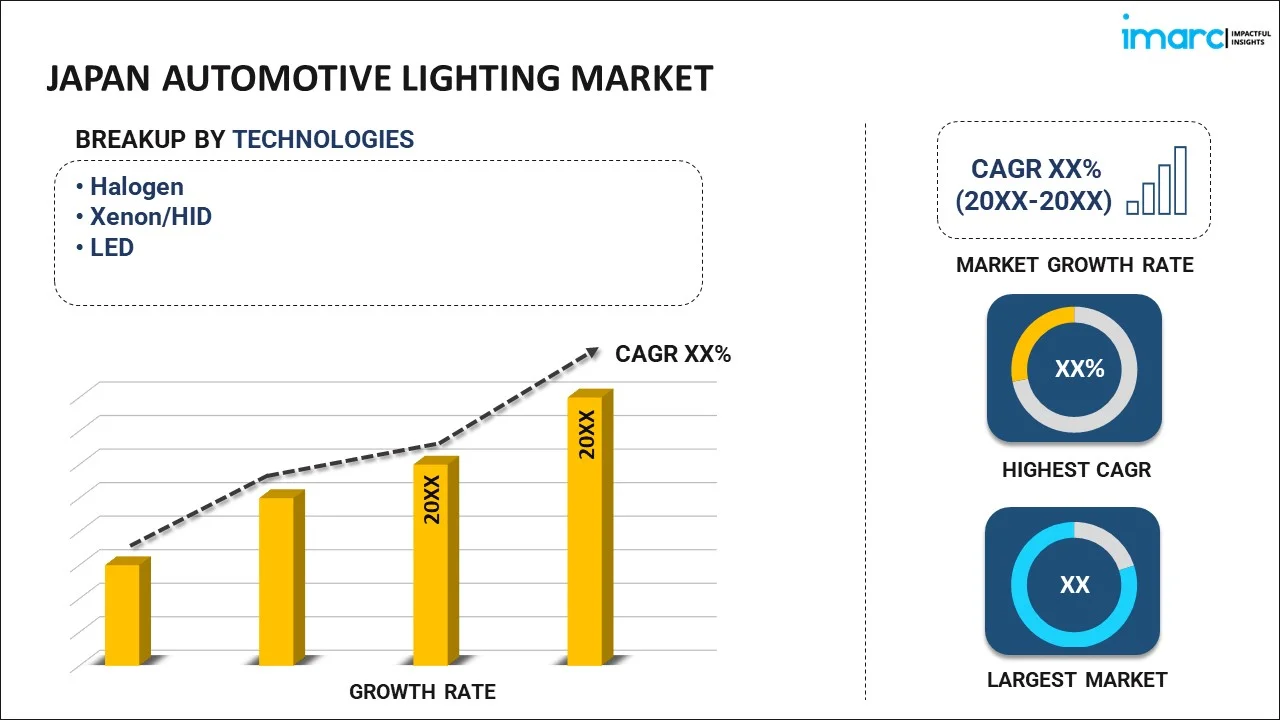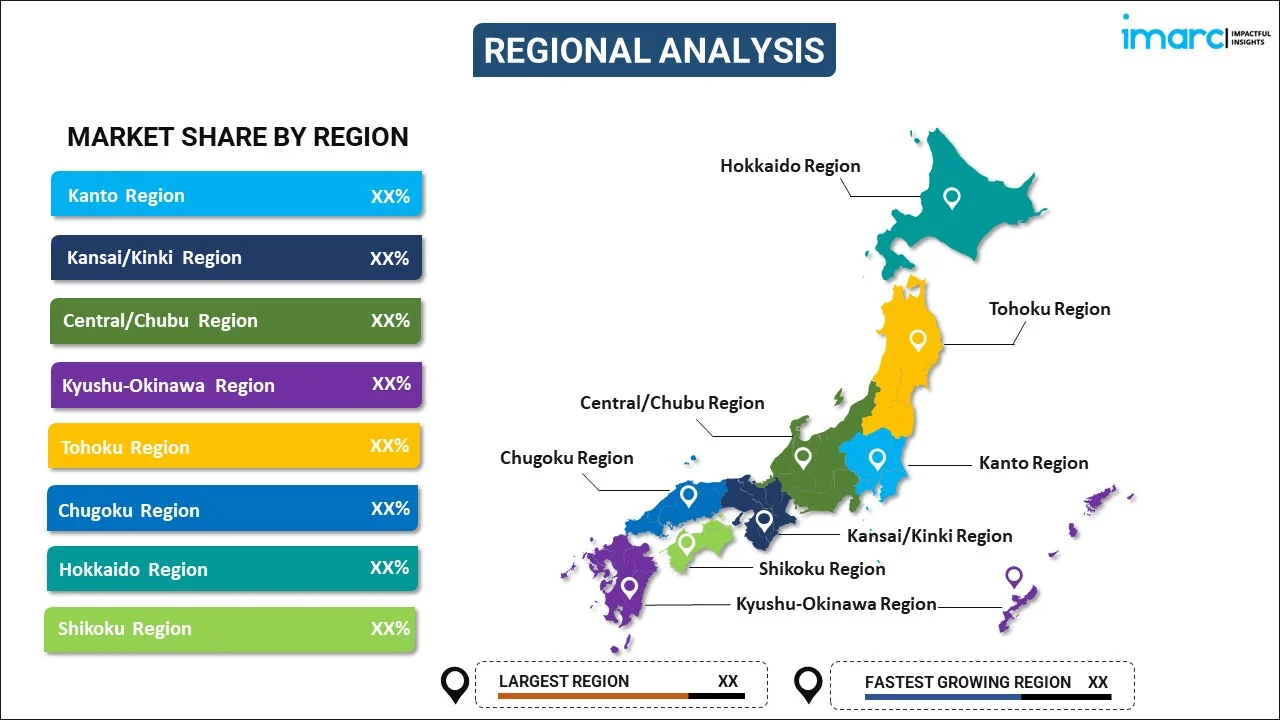
Japan Automotive Lighting Market Report by Technology (Halogen, Xenon/HID, LED), Vehicle Type (Passenger Vehicle, Commercial Vehicle), Sales Channel (Original Equipment Manufacturers, Aftermarket), Application (Front Lighting/Headlamps, Rear Lighting, Side Lighting, Interior Lighting), and Region 2025-2033
Market Overview:
Japan automotive lighting market size reached USD 2.4 Billion in 2024. Looking forward, IMARC Group expects the market to reach USD 4.4 Billion by 2033, exhibiting a growth rate (CAGR) of 6.20% during 2025-2033. The market is experiencing growth due to several factors, including a heightened awareness among individuals about road safety practices, the increasing adoption of innovative lighting technologies, a rising interest in electric vehicles (EVs), and a growing environmental awareness among the individuals.
|
Report Attribute
|
Key Statistics
|
|---|---|
|
Base Year
|
2024 |
|
Forecast Years
|
2025-2033
|
|
Historical Years
|
2019-2024
|
| Market Size in 2024 | USD 2.4 Billion |
| Market Forecast in 2033 | USD 4.4 Billion |
| Market Growth Rate (2025-2033) | 6.20% |
Automotive lighting plays a crucial role in ensuring safety, visibility, and enhancing aesthetics. It encompasses a range of lighting systems within vehicles, including headlights, taillights, fog lights, turn indicators, and interior lighting. These systems are essential for providing adequate illumination, especially in low-light conditions or adverse weather situations, thereby enhancing driver safety and reducing the risk of accidents. Headlights, whether the traditional halogen type or the modern LED or xenon variants, significantly improve visibility on the road. Additionally, fog lights are specifically designed to penetrate dense fog or heavy rain, further enhancing driver visibility in challenging weather conditions. Besides their safety functions, automotive lighting also serves as a key design element. Recent advancements in this technology have led to adaptive lighting systems that can automatically adjust the beam pattern based on driving conditions, such as curves, oncoming vehicles, or weather conditions, thereby optimizing safety and improving the overall driving experience. This dynamic field of automotive lighting continues to evolve, contributing to safer driving practices and more aesthetically appealing vehicle designs.
Japan Automotive Lighting Market Trends:
The Japan automotive lighting market is a pivotal and rapidly evolving sector within the country's automotive industry. This market's growth is driven by several key factors, including Japan's commitment to road safety and innovation, a strong focus on vehicle aesthetics, and advancements in lighting technology. In a country known for its stringent safety standards and meticulous attention to detail, automotive lighting holds a critical role in ensuring driver and pedestrian safety, especially during low-light conditions or adverse weather. Japanese automotive manufacturers are at the forefront of adopting innovative lighting technologies, including LED and xenon lights, to enhance visibility and safety on the roads. Additionally, aesthetics play a significant role in the Japanese automotive market, and lighting serves as a key design element, contributing to the overall appeal of vehicles. With continuous technological advancements, such as adaptive lighting systems and energy-efficient solutions, the Japan automotive lighting market is poised for sustained growth, offering safer driving experiences and visually appealing vehicle designs in the future.
Japan Automotive Lighting Market Segmentation:
IMARC Group provides an analysis of the key trends in each segment of the market, along with forecasts at the country level for 2025-2033. Our report has categorized the market based on technology, vehicle type, sales channel, and application.
Technology Insights:

- Halogen
- Xenon/HID
- LED
The report has provided a detailed breakup and analysis of the market based on the technology. This includes halogen, xenon/HID, and LED.
Vehicle Type Insights:
- Passenger Vehicle
- Commercial Vehicle
A detailed breakup and analysis of the market based on the vehicle type have also been provided in the report. This includes passenger vehicle and commercial vehicle.
Sales Channel Insights:
- Original Equipment Manufacturers
- Aftermarket
The report has provided a detailed breakup and analysis of the market based on the sales channel. This includes original equipment manufacturers and aftermarket.
Application Insights:
- Front Lighting/Headlamps
- Rear Lighting
- Side Lighting
- Interior Lighting
A detailed breakup and analysis of the market based on the application have also been provided in the report. This includes front lighting/headlamps, rear lighting, side lighting, and interior lighting.
Regional Insights:

- Kanto Region
- Kansai/Kinki Region
- Central/ Chubu Region
- Kyushu-Okinawa Region
- Tohoku Region
- Chugoku Region
- Hokkaido Region
- Shikoku Region
The report has also provided a comprehensive analysis of all the major regional markets, which include Kanto Region, Kansai/Kinki Region, Central/ Chubu Region, Kyushu-Okinawa Region, Tohoku Region, Chugoku Region, Hokkaido Region, and Shikoku Region.
Competitive Landscape:
The market research report has also provided a comprehensive analysis of the competitive landscape in the market. Competitive analysis such as market structure, key player positioning, top winning strategies, competitive dashboard, and company evaluation quadrant has been covered in the report. Also, detailed profiles of all major companies have been provided. Some of the key players include:
- ams-OSRAM AG
- HELLA GmbH & Co. KGaA (Faurecia SE)
- Koito Manufacturing Co. Ltd.
- Koninklijke Philips N.V.
- Stanley Electric Co. Ltd.
(Please note that this is only a partial list of the key players, and the complete list is provided in the report.)
Japan Automotive Lighting Market Report Coverage:
| Report Features | Details |
|---|---|
| Base Year of the Analysis | 2024 |
| Historical Period | 2019-2024 |
| Forecast Period | 2025-2033 |
| Units | Billion USD |
| Scope of the Report | Exploration of Historical Trends and Market Outlook, Industry Catalysts and Challenges, Segment-Wise Historical and Future Market Assessment:
|
| Technologies Covered | Halogen, Xenon/HID, LED |
| Vehicle Types Covered | Passenger Vehicle, Commercial Vehicle |
| Sales Channels Covered | Original Equipment Manufacturers, Aftermarket |
| Applications Covered | Front Lighting/Headlamps, Rear Lighting, Side Lighting, Interior Lighting |
| Regions Covered | Kanto Region, Kansai/Kinki Region, Central/ Chubu Region, Kyushu-Okinawa Region, Tohoku Region, Chugoku Region, Hokkaido Region, Shikoku Region |
| Companies Covered | ams-OSRAM AG, HELLA GmbH & Co. KGaA (Faurecia SE), Koito Manufacturing Co. Ltd., Koninklijke Philips N.V., Stanley Electric Co. Ltd., etc. |
| Customization Scope | 10% Free Customization |
| Post-Sale Analyst Support | 10-12 Weeks |
| Delivery Format | PDF and Excel through Email (We can also provide the editable version of the report in PPT/Word format on special request) |
Key Questions Answered in This Report:
- How has the Japan automotive lighting market performed so far and how will it perform in the coming years?
- What has been the impact of COVID-19 on the Japan automotive lighting market?
- What is the breakup of the Japan automotive lighting market on the basis of technology?
- What is the breakup of the Japan automotive lighting market on the basis of vehicle type?
- What is the breakup of the Japan automotive lighting market on the basis of sales channel?
- What is the breakup of the Japan automotive lighting market on the basis of application?
- What are the various stages in the value chain of the Japan automotive lighting market?
- What are the key driving factors and challenges in the Japan automotive lighting?
- What is the structure of the Japan automotive lighting market and who are the key players?
- What is the degree of competition in the Japan automotive lighting market?
Key Benefits for Stakeholders:
- IMARC’s industry report offers a comprehensive quantitative analysis of various market segments, historical and current market trends, market forecasts, and dynamics of the Japan automotive lighting market from 2019-2033.
- The research report provides the latest information on the market drivers, challenges, and opportunities in the Japan automotive lighting market.
- Porter's five forces analysis assist stakeholders in assessing the impact of new entrants, competitive rivalry, supplier power, buyer power, and the threat of substitution. It helps stakeholders to analyze the level of competition within the Japan automotive lighting industry and its attractiveness.
- Competitive landscape allows stakeholders to understand their competitive environment and provides an insight into the current positions of key players in the market.
Need more help?
- Speak to our experienced analysts for insights on the current market scenarios.
- Include additional segments and countries to customize the report as per your requirement.
- Gain an unparalleled competitive advantage in your domain by understanding how to utilize the report and positively impacting your operations and revenue.
- For further assistance, please connect with our analysts.
 Inquire Before Buying
Inquire Before Buying
 Speak to an Analyst
Speak to an Analyst
 Request Brochure
Request Brochure
 Request Customization
Request Customization




.webp)




.webp)












